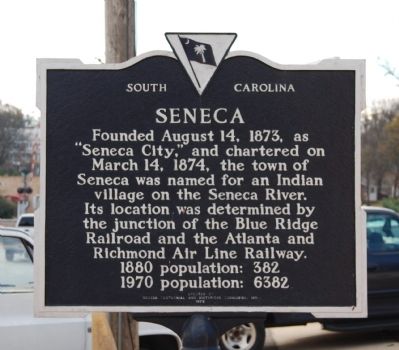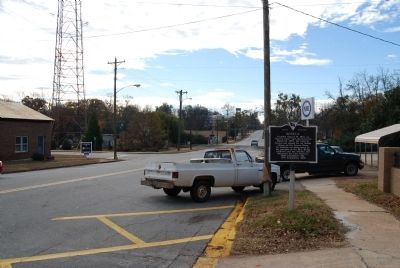Seneca in Oconee County, South Carolina — The American South (South Atlantic)
Seneca
"Seneca City," and chartered on
March 14, 1874, the town of
Seneca was named for an Indian
village on the Seneca River.
Its location was determined by
the junction of the Blue Ridge
Railroad and the Atlanta and
Richmond Air Line Railway.
1880 population: 382
1970 population: 6382
Erected 1973 by Seneca Centennial and Historic Commission, Inc. (Marker Number 37-4.)
Topics. This historical marker is listed in these topic lists: Government & Politics • Native Americans • Railroads & Streetcars • Settlements & Settlers. A significant historical date for this entry is March 14, 1874.
Location. 34° 41.067′ N, 82° 57.283′ W. Marker is in Seneca, South Carolina, in Oconee County. Marker is on South Fairplay Street. Marker is located on Fairplay Street, just north of its intersection with Railroad Street. Touch for map. Marker is in this post office area: Seneca SC 29678, United States of America. Touch for directions.
Other nearby markers. At least 10 other markers are within 4 miles of this marker, measured as the crow flies. Seneca Firsts (a few steps from this marker); Wall of Honor (approx. 0.2 miles away); Memorial Gateway (approx. 0.3 miles away); Seneca Institute / Seneca Junior College (approx. 0.4 miles away); Fairplay Community Veterans Memorial (approx. 0.4 miles away); Oconee County Training School (approx. 0.6 miles away); Oconee County World War Veterans (approx. ¾ mile away); First Soil Conservation District Plan (approx. 0.9 miles away); Newry World War II Memorial (approx. 3.9 miles away); The Church Bell (approx. 3.9 miles away). Touch for a list and map of all markers in Seneca.
Regarding Seneca. The Blue Ridge Railroad was chartered in 1852, sixteen years after John C. Calhoun first proposed building a railroad across the Blue Ridge mountains. It was the first rail line to reach the Pendleton District and Fort Hill area, in September 1860.
Also see . . .
1. Seneca, South Carolina. Wikipedia entry:
Seneca is a city in Oconee County, South Carolina, United States. (Submitted on November 29, 2008, by Brian Scott of Anderson, South Carolina.)
2. City of Seneca, SC. Official website of the city of Seneca. (Submitted on November 29, 2008, by Brian Scott of Anderson, South Carolina.)
3. Seneca Historic District. South Carolina Department of Archives and History Website entry:
Seneca is a relatively young town having celebrated its centennial in
1973. (Submitted on December 10, 2009, by Brian Scott of Anderson, South Carolina.)
4. Ram Cat Alley Historic District. South Carolina Department of Archives and History Website entry:
The Ram Cat Alley Historic District is significant as an intact public, commercial, and social center of the City of Seneca. The district is a collection of twenty-one commercial buildings in downtown Seneca. (Submitted on December 10, 2009, by Brian Scott of Anderson, South Carolina.)
5. Blue Ridge Railway (1901). Wikipedia entry (Submitted on March 20, 2021, by Larry Gertner of New York, New York.)
6. Atlanta & Richmond Air Line Railway. Wikipedia entry:
Organized in 1870, the Atlanta and Richmond Air-Line Railway combined the Georgia Air Line Rail Road and the Air Line Railroad in South Carolina under president Algernon S. Buford. (Submitted on November 29, 2008, by Brian Scott of Anderson, South Carolina.)
Additional commentary.
1. Seneca
Seneca is not an Indian name but the survival of a nickname bestowed on the Iroquois by the early Dutch traders in New York state. The Dutch nickname has clung to them from that early day to-the present. The Dutch called them Sinabars because they used red paint in their red sun-colored facial paints. Sinabar is simply the Dutch word for red-paint. The Cherokee Indians to whose territory their kinsmen, the Nunda Wadigi, came could not enunciate the sound of the labial "b" and substituted for it the hard sound of "k" and, therefore, pronounced their nickname Sineca, then softened the harsher northern enunciation to Suneka then added an initial "e" from the name of their supreme Good Spirit to indicates that these Iroquois Indians were foreigners and not equal socially, politically or in any other respect to the great body of the Cherokee people. E-su-ne-ka was corrupted by the white settlers to Isundiga which was once the name of the Savannah river from the tributaries of the Keowee to Augusta.
The novelist Simms regrets the beautiful name Isundiga had perished and wished that it might still become the name of some county or town to be preserved forever in our Indian nomenclature. The wish of our greatest novelist has materialized in the reincarnation of the name the Sun-colored people bestowed on their town three hundred years ago. Old Seneca was destroyed by Col. Andrew Williamson who led 1,860 Carolinians against it on July 31, 1776. Every house was burned to the ground, 5000 bushels of corn was destroyed, the peach trees were cut down and the green corn with all growing crops trampled in the earth. The Sun-colored people were led in the defense of their town by Cameron, the British Indian agent, and a number of Tories painted and dressed like Indians. The conquest of the town was so complete that the Indians were driven into the woods never again to return to the town they built over three hundred years ago. The little clan of Senecas was absorbed by the Cherokees and followed them finally to the Cherokee reservation west of the Mississippi river in 1838.
(Source: Historic Oconee in South Carolina by Mary Cherry Doyle (1935), pgs 8-9.)
— Submitted December 10, 2009, by Brian Scott of Anderson, South Carolina.
Credits. This page was last revised on March 20, 2021. It was originally submitted on November 29, 2008, by Brian Scott of Anderson, South Carolina. This page has been viewed 1,409 times since then and 38 times this year. Photos: 1, 2. submitted on November 29, 2008, by Brian Scott of Anderson, South Carolina.

